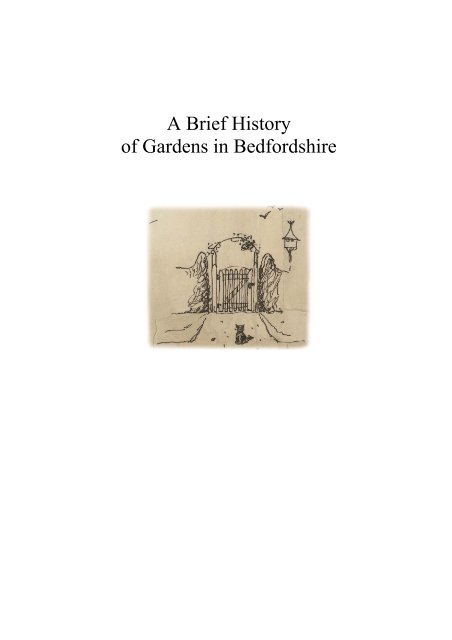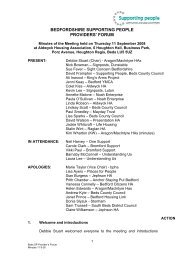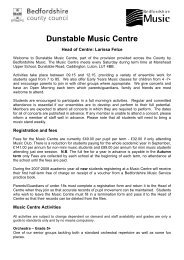A Brief History of Gardens in Bedfordshire - Bedfordshire County ...
A Brief History of Gardens in Bedfordshire - Bedfordshire County ...
A Brief History of Gardens in Bedfordshire - Bedfordshire County ...
Create successful ePaper yourself
Turn your PDF publications into a flip-book with our unique Google optimized e-Paper software.
A <strong>Brief</strong> <strong>History</strong><br />
<strong>of</strong> <strong>Gardens</strong> <strong>in</strong> <strong>Bedfordshire</strong>
A note about reference numbers<br />
Each documents held at <strong>Bedfordshire</strong> & Luton Archives Service has a unique reference, which enables us to identify<br />
one document from another. Our references are a comb<strong>in</strong>ation <strong>of</strong> letters and numbers, usually the letters at the<br />
beg<strong>in</strong>n<strong>in</strong>g <strong>of</strong> a reference <strong>in</strong>dicate the collection the document is from and the numbers which follow show where it is<br />
with<strong>in</strong> that collection, for example LHE199 is the 199 th document <strong>in</strong> the Luton Hoo Estate collection. Therefore we<br />
always refer to documents by their reference.
Mediaeval and Early Modern<br />
A <strong>Brief</strong> <strong>History</strong> <strong>of</strong> <strong>Gardens</strong> <strong>in</strong> <strong>Bedfordshire</strong><br />
Early <strong>in</strong> the development <strong>of</strong> English surnames, it is likely that the people, who are mentioned as le<br />
Gard<strong>in</strong>ers (the Gardeners) actually were gardeners <strong>in</strong> the places <strong>in</strong> which they appear.<br />
The earliest reference specifically to a <strong>Bedfordshire</strong> gardener is <strong>in</strong> the Court records <strong>of</strong> the Eyre <strong>of</strong><br />
1202, (<strong>Bedfordshire</strong> Historical Records Society [BHRS] Volume 1). Godw<strong>in</strong> Gard<strong>in</strong>er, along with<br />
a number <strong>of</strong> other men, was falsely accused <strong>of</strong> steal<strong>in</strong>g fowls at Will<strong>in</strong>gton. Miles Gard<strong>in</strong>ar acted<br />
as a pledge for Robert Blund <strong>in</strong> a case <strong>of</strong> attack on Ralph Key. The place is not given but it was<br />
somewhere <strong>in</strong> the Hundred <strong>of</strong> Wixamtree.<br />
The Subsidies <strong>of</strong> 1309 and 1332 (Suffolk Green Book Volume XVIII) list names; some <strong>of</strong> which<br />
are occupation based. In 1309 thirteen Gardeners/le Gardeners are mentioned. They are <strong>in</strong>:<br />
Campton with Shefford, Bedford, Card<strong>in</strong>gton, Cranfield, Eastcotts, Elstow, Harrold, Marston,<br />
Shelton, two <strong>in</strong> Houghton Regis, and two <strong>in</strong> Thurleigh. In the 1332 Subsidy there were eight<br />
Gardeners at: Bedford, Carlton, Houghton Regis, Shefford cum Campton, Marston, Shelton,<br />
Stagsden, Thurleigh. It is <strong>in</strong>terest<strong>in</strong>g that none <strong>of</strong> these men and women came from East<br />
<strong>Bedfordshire</strong>, later the centre <strong>of</strong> the Market Garden<strong>in</strong>g <strong>in</strong>dustry.<br />
The Coroner's Rolls (published <strong>in</strong> BHRS Volume 41) <strong>in</strong> their descriptions <strong>of</strong> the circumstances <strong>of</strong><br />
death, give a number <strong>of</strong> little vignettes <strong>of</strong> life <strong>in</strong> the 1270s:<br />
At about prime on 16 February 1271, Alexander le Gard<strong>in</strong>er <strong>of</strong> Potton , Lady Christ<strong>in</strong>e de<br />
Fornival's servant, was digg<strong>in</strong>g under the walls <strong>of</strong> an old dovecote <strong>in</strong> the garden <strong>in</strong> lady<br />
Christ<strong>in</strong>e's court yard <strong>in</strong> Sutton to demolish them, and as he dug, the wall fell by<br />
misadventure upon him and broke his head so that he immediately died there. His wife<br />
Alice came with his breakfast, looked for him, saw his surcoat and cap and the spade with<br />
which he dug and so found him dead and his whole body broken.<br />
References to gardens <strong>in</strong> <strong>Bedfordshire</strong> title deeds are comparatively few prior to the 16th Century.<br />
The earliest we have found <strong>in</strong> archives held at <strong>Bedfordshire</strong> & Luton Archives Service dates from<br />
about 1200 and is to “the garden <strong>of</strong> Gravenhurst with the ditches surround<strong>in</strong>g it” (document<br />
reference: LJeayes378).<br />
(LJeayes378)<br />
Sometime after 1233 the Prior <strong>of</strong> Newnham granted to Ge<strong>of</strong>frey son <strong>of</strong> Ralph <strong>of</strong> Renhold<br />
our court <strong>in</strong> the same vill, where lately was our garden from opposite the court <strong>of</strong> the<br />
aforesaid Ge<strong>of</strong>frey, just as it is enclosed by a ditch, except the curtilage <strong>of</strong> the Vicar just as<br />
Robert <strong>of</strong> Ely, late Vicar <strong>of</strong> this vill held it (Russell Mediaeval deeds <strong>in</strong> Box R213)<br />
Other deeds at <strong>Bedfordshire</strong> & Luton Archives referr<strong>in</strong>g to gardens <strong>in</strong>clude: TW84, which records<br />
the grant<strong>in</strong>g <strong>of</strong> two parts <strong>of</strong> a messuage with a garden with a thorn hedge, cr<strong>of</strong>t etc <strong>in</strong> Biddenham<br />
by Thomas Sampson to the Chapel on Biddenham [Bromham] Bridge, 1385.<br />
1
A <strong>Brief</strong> <strong>History</strong> <strong>of</strong> <strong>Gardens</strong> <strong>in</strong> <strong>Bedfordshire</strong><br />
PR156, dated 1422, records that a messuage and garden and other land <strong>in</strong> Little Staughton was<br />
granted to John Crowe. Another messuage <strong>in</strong> Over End was described as next to the Garden <strong>of</strong> the<br />
Prior <strong>of</strong> the Knights Hospitalers.<br />
A deed <strong>of</strong> 1479 (TW347), which refers back to deeds <strong>of</strong> 1422, shows that gardens were already an<br />
urban phenomena. A house <strong>in</strong> School Street [now east part <strong>of</strong> Mill Street] <strong>in</strong> Bedford was abutted<br />
by the way lead<strong>in</strong>g to Gold<strong>in</strong>gton (Castle Road) and the garden <strong>of</strong> John Fyssher, the Glover.<br />
Flowers are <strong>of</strong>ten mentioned <strong>in</strong> mediaeval deeds, as part <strong>of</strong> the service the tenant had to render to<br />
his Lord. Document LHE199 <strong>of</strong> circa 1300 mentions a rent <strong>of</strong> "unm clavum gert<strong>of</strong>ferum" - a clove<br />
gillyflower (Dianthus caryophyllus). A deed poll <strong>of</strong> 1 March 1409 made by Hugh Hasilden,<br />
William Gold<strong>in</strong>gton, William Cotherstoke and Richard, Vicar <strong>of</strong> Ravensden, granted a messuage,<br />
2 t<strong>of</strong>ts, 192.5 acres <strong>of</strong> land, 5 acres <strong>of</strong> meadow, 8 acres <strong>of</strong> pasture and 3 acres <strong>of</strong> wood <strong>in</strong> Renhold,<br />
Salpho, Ravensden and Gold<strong>in</strong>gton; 18.5 acres <strong>of</strong> land <strong>in</strong> Bedford and a messuage, 60 acres <strong>of</strong><br />
land, 3 acres <strong>of</strong> meadow, 4 acres <strong>of</strong> pasture and 3 acres <strong>of</strong> wood <strong>in</strong> Renhold, Salpho, Ravensden<br />
and Gold<strong>in</strong>gton to the Prior and Priory <strong>of</strong> Newnham for a term <strong>of</strong> 5 years at a rent <strong>of</strong> one red rose<br />
to be given on feast <strong>of</strong> the birth <strong>of</strong> St. John the Baptist. (Russell Box 213).<br />
L25/38 Common Recovery, 1653, note rent <strong>in</strong> the last l<strong>in</strong>e <strong>of</strong> “two Pounds <strong>of</strong> Pepper & Six Redd Roses”<br />
2
A <strong>Brief</strong> <strong>History</strong> <strong>of</strong> <strong>Gardens</strong> <strong>in</strong> <strong>Bedfordshire</strong><br />
Sixteenth and early Seventeenth Centuries<br />
In the 1530s the extensive monastic lands <strong>in</strong> <strong>Bedfordshire</strong> were seized by the K<strong>in</strong>g, much <strong>of</strong> this<br />
land was then sold to secular landowners or given to Oxbridge Colleges. The pr<strong>of</strong>its were placed<br />
<strong>in</strong> a special Court <strong>of</strong> Augmentations. These records for <strong>Bedfordshire</strong> for 1542 have been published<br />
by BHRS (Vols.63-64.) They make numerous references to topography as well as people.<br />
Incidentally they give a large number <strong>of</strong> references to gardens. Fifteen houses with gardens, for<br />
example, are listed among the tenants <strong>of</strong> will <strong>in</strong> the town <strong>of</strong> Woburn. The George had a garden<br />
and among its lands it had a garden plot between two closes. Francis Bryan held the farm <strong>of</strong> the<br />
site <strong>of</strong> the late monastery [i.e. Woburn Abbey] with three pightles <strong>of</strong> pasture & various gardens,<br />
orchards and lez Stewes and fish enclosed with<strong>in</strong> walls <strong>of</strong> the said monastery.<br />
The description <strong>of</strong> Warden Abbey does not specifically mention gardens but gives a good<br />
impression <strong>of</strong> land use <strong>in</strong> the area <strong>of</strong> the old monastery.<br />
The farm on the site <strong>of</strong> the late monastery with all outhouses & build<strong>in</strong>gs & certa<strong>in</strong><br />
lands, meadows and pastures, late occupied to the use <strong>of</strong> the monastery, that is “1 Close<br />
called le greate Vyneyard, lytell Vyneyard & le barton [i.e. farm yard], conta<strong>in</strong><strong>in</strong>g 50<br />
acres, 1 great pond with 2 little ponds adjacent. Amongst the land laid down to pasture<br />
etc were 6 acres called le Grove & 2 orchards called le hopyard and le pondyard.”<br />
The field system is depicted on a map <strong>of</strong> circa 1750 (reference Z1125/1).<br />
The Sixteenth Century saw the lay<strong>in</strong>g out <strong>of</strong> formal gardens for exercise (parallel to the Long<br />
Gallery <strong>in</strong> the ma<strong>in</strong> house itself). Herb gardens <strong>in</strong>creased. Books were published on garden<br />
techniques and how to use plants for medic<strong>in</strong>al purposes, such as Turner’s A New Herbal,<br />
published <strong>in</strong> three parts <strong>in</strong> 1551, 1562, 1568; the first <strong>in</strong> vernacular English. Orchards become<br />
more important both for fruit and prepar<strong>in</strong>g cider. Landowners began to see the relationship <strong>of</strong><br />
their houses to the surround<strong>in</strong>g landscape.<br />
A particularly grand house, Todd<strong>in</strong>gton Manor is shown on<br />
Ralph Agas's map <strong>of</strong> 1581, (Orig<strong>in</strong>al British Library Add<br />
MS.38065; copy held BLARS X1/102/H (right)). It shows two<br />
blocks <strong>of</strong> formal gardens with smaller squares transected by walks.<br />
These were called the Great and Little <strong>Gardens</strong> respectively and<br />
were surrounded by walls. The wider landscape <strong>in</strong>cluded a deer<br />
park, a rabbit warren, orchards and twenty fish ponds, well stocked<br />
with fresh fish. The house was probably built <strong>in</strong> c. 1545 and the<br />
garden laid out at the same time.<br />
There had been parks throughout the Middle Ages, such as Wrest;<br />
first reference <strong>in</strong> 1330, (Victoria <strong>County</strong> <strong>History</strong>). They were used<br />
partly for hunt<strong>in</strong>g. James I made a number <strong>of</strong> trips to <strong>Bedfordshire</strong> to hunt at places such as<br />
Bletsoe Park. The Countess <strong>of</strong> Pembroke deliberately made her new house <strong>of</strong> Houghton House <strong>in</strong><br />
the early 17C face north, so that she and her guests could watch the hunt<strong>in</strong>g. The park was seen as<br />
a suitable landscape sett<strong>in</strong>g for an important house.<br />
Smaller parks were probably used as areas for graz<strong>in</strong>g cattle etc. The Luton Hoo deed LHE199 <strong>of</strong><br />
circa 1300 describes a piece <strong>of</strong> meadow <strong>in</strong> West Hyde <strong>in</strong> the parish <strong>of</strong> Luton as between the park<br />
that was <strong>of</strong> Walter atte Made <strong>of</strong> Wheathamstead and the park that was <strong>of</strong> Richard Eldhew's.<br />
3
A <strong>Brief</strong> <strong>History</strong> <strong>of</strong> <strong>Gardens</strong> <strong>in</strong> <strong>Bedfordshire</strong><br />
The Manor <strong>of</strong> Bromham had been divided between the co-heiresses <strong>of</strong> John de Beauchamp,<br />
follow<strong>in</strong>g his death at the Battle <strong>of</strong> Evesham <strong>in</strong> 1265. By the 16 th Century all except one <strong>of</strong> these<br />
had fallen <strong>in</strong>to the hands <strong>of</strong> the Dyve family. When the last division (based to the south <strong>of</strong><br />
Bromham Church and thus surrounded by Dyve's land) came up for sale it was purchased by the<br />
their great rivals, the Botelers <strong>of</strong> Ford End, Biddenham. The case papers give a fasc<strong>in</strong>at<strong>in</strong>g picture<br />
<strong>of</strong> the lengths the Dyves were prepared to go to shift the Botelers and be able to make a park,<br />
which <strong>in</strong> its turn formed part <strong>of</strong> a general enclosure <strong>of</strong> the whole parish. On 29 December 1588,<br />
John Dyve (son <strong>of</strong> the owner <strong>of</strong> Bromham Hall) and 16 or 17 others, be<strong>in</strong>g armed with swords and<br />
buckler, daggers, long pikes, staves, forest bills and other weapons 'as well <strong>in</strong>vasive as defensive,'<br />
waylaid William Boteler as he was walk<strong>in</strong>g home from Biddenham Church to his house at Ford<br />
End. Boteler was left for dead '<strong>in</strong> that he bled and was stricken down to the grounde.’ Three <strong>of</strong> his<br />
servants were wounded: Peter Sampson was wounded <strong>in</strong> the gullet, Andrew Wright lost two<br />
f<strong>in</strong>gers <strong>of</strong> the left hand and Robert Sampson was wounded <strong>in</strong> the right arm and elsewhere<br />
(TW1015-1062). In 1595 Boteler leased the ground known as Walnut Tree Close 'on which one<br />
walnut tree stands.' Agreement was f<strong>in</strong>ally reached between Sir John and Boteler's widow & son<br />
<strong>in</strong> 1605.<br />
In 1624 the area around the Bushmead<br />
manor house, left, shows little <strong>in</strong> the<br />
way <strong>of</strong> gardens but may show an<br />
orchard with dovecote and ponds<br />
(GY4/1).<br />
A survey <strong>of</strong> Ampthill Great Park, made <strong>in</strong> 1639, describes the Great Lodge, its outbuild<strong>in</strong>gs and<br />
gardens<br />
Which said Cappitall house & build<strong>in</strong>gs advance ymselves up on a very pleasant hill<br />
w’th<strong>in</strong> ye sd pk as aforesd, hav<strong>in</strong>g a delectable prospect over ye sd pk & country, the<br />
front where<strong>of</strong> to ye southwards is beautified wth a convenient courtyeard & a Garden or<br />
young Orchard on ye west end there<strong>of</strong>. And wth a kitch<strong>in</strong> Garden at ye east end the<strong>of</strong>,<br />
wch said orchards or <strong>Gardens</strong> are surrounded wth a non sawen pale. (R6/1/1/13)<br />
However, it is to poetry that we have to look to get the best idea <strong>of</strong> an early 17 th century landscape<br />
and garden. Thomas Carew wrote 'To my friends GN from Wrest' (transcribed <strong>in</strong> S.R. Houfe's<br />
Through Visitors' Eyes, Dunstable, 1990; copy <strong>in</strong> Searchroom: 160) <strong>in</strong> late 1639 or early 1640.<br />
The poem contrasts the peace <strong>of</strong> Wrest with the bleakness <strong>of</strong> the Borders dur<strong>in</strong>g Charles's War<br />
with Scotland.<br />
But where more bounteous Nature bears a part<br />
And guides her handmaid, if she but dispense<br />
Fit matter, she with care and diligence<br />
Employs her skill; for where the neighbour source<br />
Pours forth her Waters; she directs their course,<br />
And enterta<strong>in</strong>s the flow<strong>in</strong>g streams <strong>in</strong> deep<br />
And spacious channels, where they slowly creep<br />
In snaky w<strong>in</strong>d<strong>in</strong>gs, as the shelv<strong>in</strong>g ground<br />
4
A <strong>Brief</strong> <strong>History</strong> <strong>of</strong> <strong>Gardens</strong> <strong>in</strong> <strong>Bedfordshire</strong><br />
Leads them <strong>in</strong> circles, till they twice surround<br />
This island mansion, which I' th centre placed,<br />
Is with a double crystal heaven embraced;<br />
In which our watery constellations float,<br />
Our fishes, swans, our water-man and boat,<br />
…..<br />
Whilst our <strong>in</strong>crease <strong>in</strong> fertile waters here<br />
Disport and wander freely where they please,<br />
With<strong>in</strong> the circuit <strong>of</strong> our narrow seas.<br />
With various trees we fr<strong>in</strong>ge the water's br<strong>in</strong>k ,<br />
Whose thirsty roots the soak<strong>in</strong>g moisture dr<strong>in</strong>k:<br />
And whose boughs <strong>in</strong> equal ranks<br />
Yield fruit, and shade, and beauty to the banks.<br />
On this site young Vertumnus sits, and courts<br />
His ruddy cheeked 'd Pomona ;Zephyr sports<br />
On th' other, with loved Flora, yield<strong>in</strong>g there<br />
Sweets for the small, sweets for the palate here.<br />
But did you taste the high and mighty dr<strong>in</strong>k<br />
Which from that founta<strong>in</strong> flows<br />
From this we can gather that Wrest had two moats and plenty <strong>of</strong> streams nearby, which were used<br />
for supply<strong>in</strong>g fish. There were f<strong>in</strong>e orchards (Pomona) and flowers (Flora). In addition there was<br />
the Old Park, which was based on the mediaeval park. Richard De Grey had made good his claim<br />
to have a park here <strong>in</strong> 1344. (<strong>Bedfordshire</strong> Victoria <strong>County</strong> <strong>History</strong> Vol. II page 331)<br />
The Restoration; the Growth <strong>of</strong> the Classical Garden<br />
The enforced exile <strong>of</strong> the future Charles II and his lead<strong>in</strong>g supporters <strong>in</strong> Europe laid them open to<br />
classical ideas <strong>in</strong> both architecture and garden design. The ma<strong>in</strong> <strong>in</strong>fluence was French, either<br />
directly or with Dutch and German <strong>in</strong>fluences <strong>in</strong> 1688 & 1714.While Inigo Jones had <strong>in</strong>troduced<br />
classical themes <strong>in</strong>to architecture before 1640, it was only after 1660 that these extended to<br />
gardens.<br />
The variety <strong>of</strong> landscape surround<strong>in</strong>g an important house is shown by Thomas Moore's map the<br />
Mannor <strong>of</strong> Woburn <strong>in</strong> 1661 (X1/33/1 (below)).<br />
The house was built round a<br />
courtyard, and would have<br />
<strong>in</strong>cluded parts <strong>of</strong> the mediaeval<br />
build<strong>in</strong>g. The south w<strong>in</strong>g, which<br />
looks Seventeenth Century,<br />
looked out on an enclosed area,<br />
which had a pond as its<br />
centrepiece and <strong>in</strong>cluded a<br />
number <strong>of</strong> rows <strong>of</strong> trees. West<br />
<strong>of</strong> the house was a sundial and<br />
to the north <strong>of</strong> it a formal<br />
parterre with the paths <strong>in</strong> the<br />
shape <strong>of</strong> St Andrew’s cross.<br />
North <strong>of</strong> this lay another<br />
wooded area. To the west <strong>of</strong> the<br />
gardens proper, which were enclosed by a wall, was the kitchen garden and the Gate House. All<br />
this was small scale and <strong>in</strong> the immediate vic<strong>in</strong>ity <strong>of</strong> the house.<br />
5
A <strong>Brief</strong> <strong>History</strong> <strong>of</strong> <strong>Gardens</strong> <strong>in</strong> <strong>Bedfordshire</strong><br />
When Celia Fiennes visited Woburn <strong>in</strong> 1697 she described Woburn’s garden as f<strong>in</strong>e<br />
there is a large bowl<strong>in</strong>g-green with 8 arbours kept cut neately, and seates <strong>in</strong> each, there is<br />
a seate up <strong>in</strong> a high tree that ascends from the green 50 steps, that commandes the whole<br />
parke round to see the Deer hunted, as also a large prospect <strong>of</strong> the Country; there are 3<br />
large <strong>Gardens</strong>, full <strong>of</strong> fruite – I eate a great quantety <strong>of</strong> the Red Coral<strong>in</strong>a goosbery which<br />
is a large th<strong>in</strong> sk<strong>in</strong>’d sweete goosebery – the walks are one above another with stone steps;<br />
<strong>in</strong> the square just be the d<strong>in</strong>e<strong>in</strong>g roome w<strong>in</strong>dow is all sorts <strong>of</strong> pots <strong>of</strong> flowers and curious<br />
greens f<strong>in</strong>e orange citron and lemon trees and mirtles strip’d filleroy and the f<strong>in</strong>e aloes<br />
plant; on the side <strong>of</strong> this pass under an arch <strong>in</strong>to a Cherry garden, <strong>in</strong> the midst <strong>of</strong> which<br />
stands a figure <strong>of</strong> stone resembl<strong>in</strong>g an old weeder woman used <strong>in</strong> the garden, and my Lord<br />
would have her Effigie which is done so like and her clothes so well that at first I tooke it<br />
to be a real liv<strong>in</strong>g body; on the flatts are fish ponds the whole length <strong>of</strong> the walke; above<br />
that <strong>in</strong> the next flat is 2 fish ponds, here are dwarfe trees spread <strong>of</strong> a great bigness.<br />
Like Woburn, Wrest was developed <strong>in</strong> the second half <strong>of</strong> the 17 th century. Beg<strong>in</strong>n<strong>in</strong>g <strong>in</strong> 1658 and<br />
cont<strong>in</strong>u<strong>in</strong>g through to the early 18 th century it saw the creation <strong>of</strong> parterres, and the plant<strong>in</strong>g <strong>of</strong><br />
fruit and avenues <strong>of</strong> trees. [see Case Studies for more detail]<br />
At Ampthill Park Lord Ashburnham was plant<strong>in</strong>g extensively from 1695 onwards. In November<br />
1695 he ordered Mr Parker to ‘have gotten ready on demand two hundred <strong>of</strong> the Dutch Standard<br />
Elmes you mentioned’ In October he had mentioned purchas<strong>in</strong>g limes and fruit trees, <strong>in</strong>clud<strong>in</strong>g six<br />
cherry trees from Sussex. He also says that ‘he will have occasion for some excellent apara grasse,<br />
and all other th<strong>in</strong>gs to plant and stock a kitchen garden hav<strong>in</strong>g this last summer caused a plot <strong>of</strong><br />
ground to be walled round for that purpose.’<br />
Further letters show that additional plant<strong>in</strong>g was tak<strong>in</strong>g place a decade later. On 30 January<br />
1706/1707 Parker had to ‘goe to Battersea over aga<strong>in</strong>st Chelsea, see among the gardeners there to<br />
procure one thousand setts, <strong>of</strong> the large sorte <strong>of</strong> Asparagus’ On 1 March 1706/1707 <strong>in</strong> a letter to<br />
Nicholas Parker, Lord Ashburnham wrote from Ampthill Park: ‘I have present occasion for 30<br />
lyme trees, large, well growen & rooted all <strong>of</strong> the Female k<strong>in</strong>d and flower<strong>in</strong>g trees which I desire<br />
you will send me downe to Ampthill Parke by this next return the Carrier without fayle’. (East<br />
Sussex Record Office ASH/4461-66, BLARS Micr<strong>of</strong>ilm 180).<br />
Colworth House,<br />
Sharnbrook, 1715, show<strong>in</strong>g<br />
the gardens around the<br />
house just before the house<br />
was rebuilt. The<br />
redevelopment <strong>of</strong> the<br />
gardens and park followed<br />
<strong>in</strong> the mid 18 th century.<br />
(GA2955)<br />
6
The Eighteenth Century<br />
A <strong>Brief</strong> <strong>History</strong> <strong>of</strong> <strong>Gardens</strong> <strong>in</strong> <strong>Bedfordshire</strong><br />
In the early 18 th century a number <strong>of</strong> large houses were built or rebuilt <strong>in</strong> <strong>Bedfordshire</strong> and their<br />
new gardens obviously reflected the style <strong>of</strong> the day.<br />
Between 1709 and 1714 H<strong>in</strong>wick House was built for Richard and Diana Orlebar. A walled<br />
garden was created on the west side and an oval lawn with a sundial as it centrepiece on the south<br />
side. This is shown on a contemporary picture (reproduced <strong>in</strong> Country Life <strong>of</strong> 22 September 1960<br />
copy <strong>in</strong> BLARS reference CRT130Pod<strong>in</strong>gton3).<br />
In 1725, Heylock K<strong>in</strong>gsley entered <strong>in</strong>to agreements with local holders <strong>of</strong> common rights so he<br />
could impark the area round the Hasells, Sandy. It is likely that the terraces, <strong>in</strong>clud<strong>in</strong>g the<br />
Bowl<strong>in</strong>g Green at the bottom and two <strong>of</strong> the three wall gardens were part <strong>of</strong> this landscap<strong>in</strong>g. Both<br />
features are expla<strong>in</strong>ed by the particular problems <strong>of</strong> garden<strong>in</strong>g on a ridge otherwise unprotected<br />
from the prevail<strong>in</strong>g southwest w<strong>in</strong>d.<br />
Meanwhile the established gardens at, for example, Woburn and Wrest were adapted <strong>in</strong> various<br />
ways. The mid 1720s probably saw the peak <strong>of</strong> the formal design<strong>in</strong>g <strong>of</strong> the gardens at Wrest.<br />
A useful summary <strong>of</strong> the shape <strong>of</strong> a number <strong>of</strong> <strong>Bedfordshire</strong> landscapes is provided by Thomas<br />
Jeffreys’s map <strong>of</strong> 1765. There are drives through Chicksands Wood but not close to the house.<br />
Luton Hoo had an extensive park <strong>in</strong>clud<strong>in</strong>g an obelisk. In East Hide were two formal avenues<br />
with formal plantations beh<strong>in</strong>d; similarly there were two formal plantations either side <strong>of</strong> access<br />
drive at Stockwood, Luton. Odell Great Wood was already divided <strong>in</strong>to formal drives based on<br />
the design <strong>of</strong> the wheel. There were formal drives also <strong>in</strong> Potton Woods. To the north <strong>of</strong><br />
Houghton House two double avenues extended beyond the road from Houghton Conquest. At<br />
Todd<strong>in</strong>gton Manor there are three ponds be<strong>in</strong>g fed by a tributary <strong>of</strong> the Flitt. They look like<br />
fishponds and may be part <strong>of</strong> an earlier landscape. To the north east <strong>of</strong> Melchbourne Park were<br />
two double avenues <strong>of</strong> trees but not lead<strong>in</strong>g up to the house, on west woods dissected by formal<br />
drives. However for some houses, such as H<strong>in</strong>wick House and Hall, no landscap<strong>in</strong>g is shown.<br />
As the century progressed many <strong>of</strong> the large gardens changed with fashion, some employed the<br />
best-known garden designers others were <strong>in</strong>fluenced by them. The garden style most attributed to<br />
England is that <strong>of</strong> the 18 th century landscape garden; a sweep<strong>in</strong>g away <strong>of</strong> the formal cont<strong>in</strong>ental<br />
styles, culm<strong>in</strong>at<strong>in</strong>g <strong>in</strong> the relaxed <strong>in</strong>formal lakes, lawns and woods <strong>of</strong> Brown and Repton.<br />
<strong>Gardens</strong> <strong>of</strong> 1720-1740 Kent and Bridgeman <strong>in</strong>fluenced<br />
Wrest, (Langley)<br />
Southill (Badeslade)<br />
Hasells<br />
Lancelot Brown<br />
Wrest, limited designs by Brown 1758-60 to s<strong>of</strong>ten the edges<br />
Southill, (between 1765-1779)<br />
Luton Hoo, designed by Brown, c1768<br />
Ampthill, designed by Brown, 1771<br />
Hasells (<strong>in</strong>fluenced?)<br />
Colworth (<strong>in</strong>fluenced?)<br />
Woburn extension <strong>of</strong> Park to Husborne Crawley 1760 (after enclosure)<br />
Humphrey Repton<br />
Hasells (1791)<br />
Moggerhanger (1792, 1798)<br />
Woburn (c1807)<br />
Battlesden (before 1808)<br />
7
A <strong>Brief</strong> <strong>History</strong> <strong>of</strong> <strong>Gardens</strong> <strong>in</strong> <strong>Bedfordshire</strong><br />
Brown was not the only landscape gardener <strong>of</strong> the 1760s and 70s. At the Hasells, Sandy, the<br />
1760s saw the extension and completion <strong>of</strong> the work that had been done dur<strong>in</strong>g Heylock<br />
K<strong>in</strong>gsley’s time and between 1765 and 1767 Colonel Parker and Nathaniel Richmond were<br />
<strong>in</strong>volved <strong>in</strong> this. Nathaniel Richmond was paid £17, 6s, 6d for 11 days attendance at Hasells and it<br />
is thought he was the designer <strong>of</strong> the landscape improvements (Francis Pym Sentimental Journey,<br />
1998 p24). At the end <strong>of</strong> the terraces, pavilions were erected for William Pym and the walled<br />
gardens built. The bricks cost £6s 6d per thousand. The park was enlarged aga<strong>in</strong> <strong>in</strong> the 1770s.<br />
Labour <strong>in</strong> the new kitchen garden at Hasells, 1765 (PM2380)<br />
The Dovehouse close and Horse close became part <strong>of</strong> the garden lawn <strong>in</strong> 1770, more ground was<br />
added to the lawn <strong>in</strong> 1775 and by 1786 two groves and the wood had also been added. (PM1571)<br />
In 1772 John Parker was paid £4 17s, 11d for digg<strong>in</strong>g the river below the bridge at Colworth <strong>in</strong><br />
Sharnbrook parish for William Lee. In 1776 Parker started work on a section <strong>of</strong> the top lake. The<br />
8
A <strong>Brief</strong> <strong>History</strong> <strong>of</strong> <strong>Gardens</strong> <strong>in</strong> <strong>Bedfordshire</strong><br />
six men were paid £141 for six months work. Nearly 700 trees were delivered from Kenn<strong>in</strong>gton<br />
Nursery <strong>in</strong> 1778 (UN252).<br />
The 1794 Map <strong>of</strong> Card<strong>in</strong>gton (W2/6/1) shows a transitional garden at Howard House, which had<br />
a formal centre with walks at right angles, form<strong>in</strong>g a cross and w<strong>in</strong>d<strong>in</strong>g paths on the outside. The<br />
centre must always have been sunken with the w<strong>in</strong>d<strong>in</strong>g paths on higher ground. The ha-ha at the<br />
east end <strong>of</strong> the present garden may well date from this period. A garden opposite the church<br />
consists <strong>of</strong> a circular walk round a wooded area.<br />
9
The N<strong>in</strong>eteenth Century<br />
A <strong>Brief</strong> <strong>History</strong> <strong>of</strong> <strong>Gardens</strong> <strong>in</strong> <strong>Bedfordshire</strong><br />
As <strong>in</strong> the 18 th century, the 19 th saw <strong>Bedfordshire</strong> gardens mov<strong>in</strong>g with the times. At the beg<strong>in</strong>n<strong>in</strong>g<br />
<strong>of</strong> the century Old Warden Park was be<strong>in</strong>g developed by Robert, 2 nd Lord Ongley. In the first<br />
decade Repton was at work at Woburn and Battlesden and <strong>in</strong> 1813 James Wyatt was redesign<strong>in</strong>g<br />
the Chicksands Priory estate. The 1820s and 1830s saw the lay<strong>in</strong>g out <strong>of</strong> the Swiss Garden at<br />
Old Warden by Robert, 3 rd Lord Ongley.<br />
Battlesden Park, c. 1813 from a<br />
watercolour by Thomas Fisher<br />
(Slide209)<br />
One <strong>of</strong> the <strong>Bedfordshire</strong> landscapes most altered <strong>in</strong> the first half <strong>of</strong> the N<strong>in</strong>eteenth Century was<br />
Flitwick Manor. The 1793 Map <strong>of</strong> Flitwick (LL4/1) shows that the Manor House was split from<br />
the church by a road. To the south east <strong>of</strong> the house was a slim area <strong>of</strong> pleasure ground beyond<br />
this was the Paddock <strong>in</strong>clud<strong>in</strong>g the formal water, which had a different shape from that shown on<br />
the 1880s Ordnance Survey map. To the west <strong>of</strong> the house lay a Grove. From 1816 the garden was<br />
redeveloped. John Thomas Brooks’ draft will <strong>of</strong> 1834 specifically mentions his greenhouse and<br />
hothouse plants (HN2/B3/9) and <strong>in</strong> a memorandum to the will (HN2/B3/10) he observes “Hav<strong>in</strong>g<br />
spent much time attention and money <strong>in</strong> improv<strong>in</strong>g the Family Mansion & its Grounds and the<br />
Estate generally; it is my hope and wish that my child who succeeds me <strong>in</strong> it will take an equal<br />
<strong>in</strong>terest <strong>in</strong> the place and it is my particular wish and hope that he will cont<strong>in</strong>ue, and preserve and<br />
perpetuate the museum and the Botanic Garden the arboretum, especially, <strong>of</strong> which, will, if thus<br />
kept up be <strong>in</strong> after generations <strong>of</strong> great <strong>in</strong>terest and value.”<br />
Other gardens that were developed <strong>in</strong> the 19 th century <strong>in</strong>cluded Hasells and Ickwell Bury.<br />
Early Victorian gardens <strong>in</strong>clude the build<strong>in</strong>g by Samuel Charles Whitbread <strong>of</strong> a wall garden to the<br />
south east <strong>of</strong> the transitional garden at Howard House, Card<strong>in</strong>gton. The 1880s Ordnance Survey<br />
map shows this but the date stone <strong>in</strong> the wall itself gives a date <strong>of</strong> 1840. Documents cannot give<br />
all the answers. It is essential to check what is on the ground with what you can f<strong>in</strong>d <strong>in</strong> the<br />
archive.<br />
The late 19 th and early 20 th centuries saw the large estates cont<strong>in</strong>ue to change their gardens. Glass<br />
houses were built on a grand scale at Colworth and Luton Hoo amongst others.<br />
By the end <strong>of</strong> the century the Arts and Crafts movement was beg<strong>in</strong>n<strong>in</strong>g to <strong>in</strong>fluence the gardens <strong>of</strong><br />
the upper middle classes who were hav<strong>in</strong>g houses built. Barr<strong>in</strong>gton House, Biddenham was<br />
designed <strong>in</strong> 1900 by C E Mallows for his father <strong>in</strong> law, Mr Peacock, <strong>in</strong> the Arts & Crafts style and<br />
his design extended to the garden, which <strong>in</strong>cluded kitchen gardens, a tennis lawn, a wilderness and<br />
a formal garden surrounded by hedg<strong>in</strong>g.<br />
10
A <strong>Brief</strong> <strong>History</strong> <strong>of</strong> <strong>Gardens</strong> <strong>in</strong> <strong>Bedfordshire</strong><br />
Public and Private – gardens <strong>in</strong> the 19 th & 20 th centuries<br />
In the towns the late Victorian and early 20 th centuries saw the rise <strong>of</strong> the public pleasure gardens.<br />
Bedford Park opened <strong>in</strong> 1888, which was followed by Russell Park ten years later. Meanwhile<br />
the riverbanks <strong>of</strong> the Great Ouse were be<strong>in</strong>g enhanced for public enjoyment. The suspension<br />
bridge opened on the same day as Bedford Park even though it was still under construction and the<br />
Embankment and St Mary’s gardens were planned, expanded and improved from the turn <strong>of</strong> the<br />
century to the 1920s. Meanwhile <strong>in</strong> Leighton Buzzard Page’s Park opened <strong>in</strong> about 1894 and <strong>in</strong><br />
Luton Wardown Park was acquired by the council <strong>in</strong> 1904.<br />
Private gardens cont<strong>in</strong>ued to develop, for example Gertrude Jekyll produced designs for<br />
Putteridge Park <strong>in</strong> 1911 and The Old House, Ickwell <strong>in</strong> 1926-27, and between 1934 and 1948<br />
the gardens at Sandy Lodge were revitalised by Sir Malcolm Stewart and his wife. H<strong>in</strong>wick Hall,<br />
Luton Hoo and Stockgrove Park also saw changes.<br />
On a smaller scale some landowners were keen to ensure that estate cottages at least had some<br />
means to raise food for their families. The Duke <strong>of</strong> Bedford’s cottages had ‘little plots <strong>in</strong> front and<br />
large allotments either at the back or close by’ even <strong>in</strong> Woburn where gardens next the public<br />
street were limited <strong>in</strong> size, they had plots sufficiently large ‘to allow <strong>of</strong> flowers, pot-herbs, or even<br />
beds <strong>of</strong> cabbages to grow’ (R1/1029/1).<br />
Improvements <strong>in</strong> lawn mowers and other tools and the <strong>in</strong>creased<br />
availability <strong>of</strong> seeds and plants at low prices from High Street shops<br />
such as Woolworths meant that garden<strong>in</strong>g could become more <strong>of</strong> a<br />
hobby for the lower middle classes who did not rely on it for food.<br />
<strong>Bedfordshire</strong> had several well-known nurseries. Laxtons <strong>of</strong> Bedford<br />
began <strong>in</strong> the 1890s and specialised <strong>in</strong> fruit, while the Godber nurseries<br />
<strong>in</strong> Will<strong>in</strong>gton were known for their chrysanthemums and, although<br />
these bus<strong>in</strong>esses closed, the late 20 th century saw the rise <strong>of</strong> the large<br />
garden centre, <strong>in</strong>clud<strong>in</strong>g those at Pod<strong>in</strong>gton, Milton Ernest and<br />
Will<strong>in</strong>gton.<br />
11

















